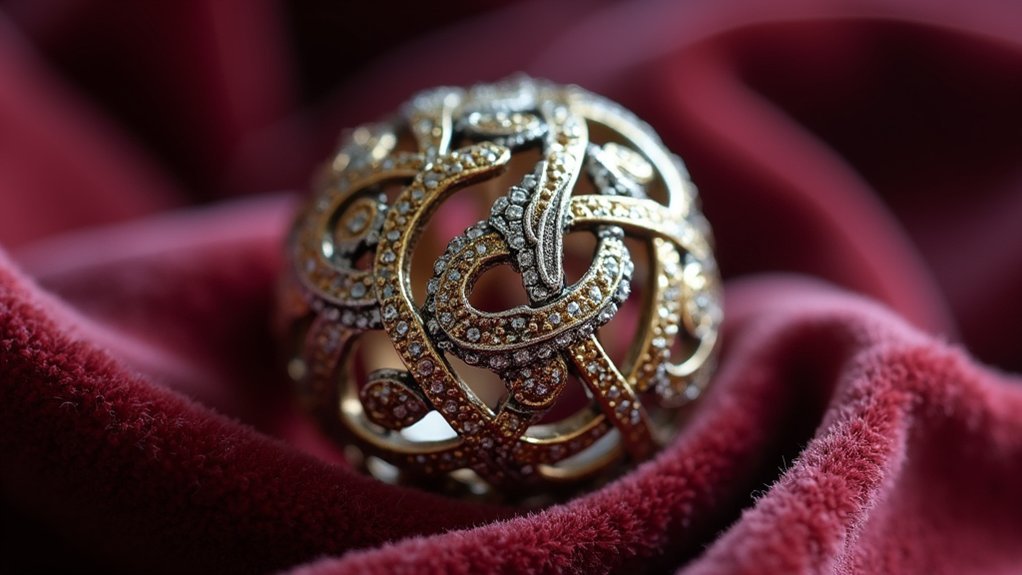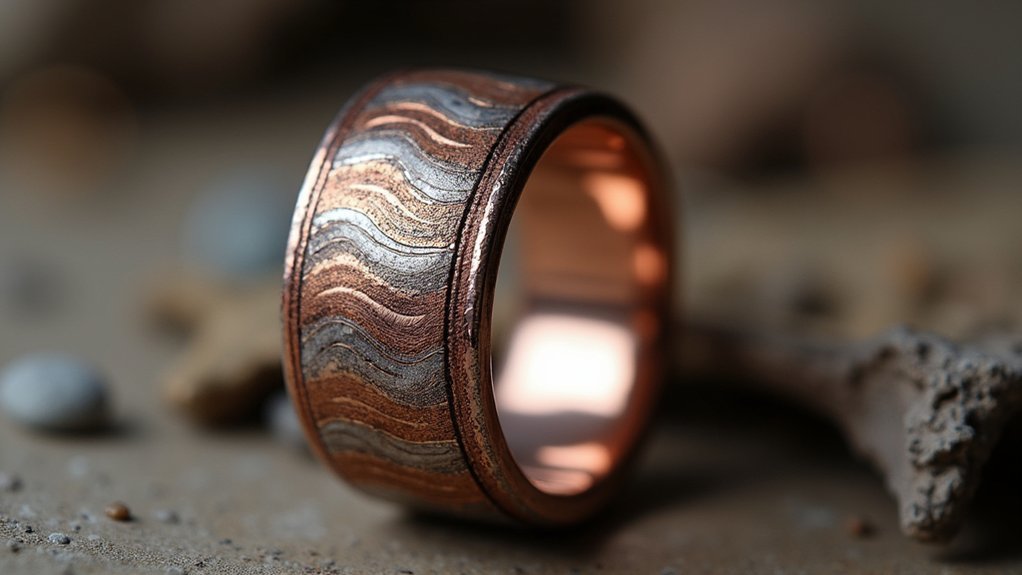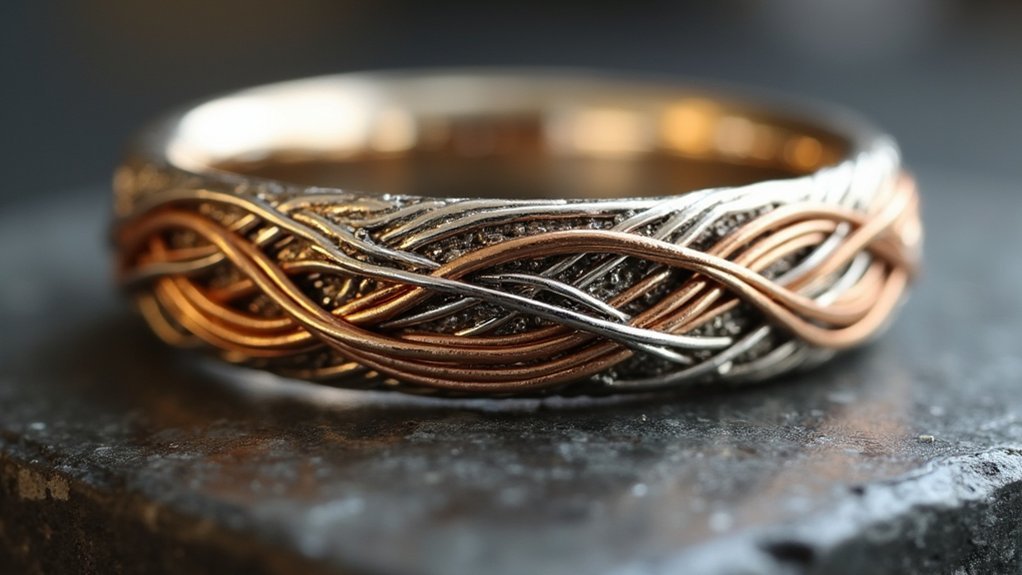Metal inlay transforms ordinary rings into wearable art through several stunning techniques. You’ll find Channel inlay with precise grooves, Japanese Mokume Gane with wood-like patterns, Wire inlay for contrast, Damascene with gold on dark steel, Korean Keum-boo for gold-silver fusion, and dramatic Niello with black sulfide accents. Each method carries rich cultural history and requires specific tools and skills. Discover how these ancient crafting traditions create jewelry pieces that showcase extraordinary artistry.
7 Beautiful Metal Inlay Methods for Stunning Rings

When crafted with precision, metal inlay techniques transform ordinary rings into extraordinary works of art.
You’ll find that these methods involve carefully cutting precise voids in your base material—typically wood or metal—to match the size and shape of your inlay materials.
To create intricate designs, you’ll need a rolling mill to shape copper or brass wire to your desired thickness.
Don’t skip annealing your metal, as this prevents cracking during placement and improves workability.
Once you’ve fitted your inlay materials snugly into the prepared voids, secure them with super glue for stability.
The final steps are essential: sand the surface until it’s perfectly smooth, then polish until your inlay gleams with a reflective finish, highlighting the contrast between your chosen metals.
Channel Inlay: Creating Recessed Pathways for Precious Metals
Channel inlay techniques require you to cut precise grooves into your metal band, creating pathways that will house your chosen inlay materials.
You’ll need specialized cutting tools to achieve clean, accurate channels with consistent depth for professional-looking results.
When selecting contrasting metals or materials for your inlay, consider combinations like copper against silver or turquoise within gold to create striking visual interest in your ring design.
Precise Cutting Techniques
Carving precise grooves into your ring’s surface forms the foundation of successful channel inlay work. You’ll need specialized tools like a jeweler’s saw or milling machine to create these recessed pathways. During the inlay process, maintain consistent width and depth measurements to guarantee your inlay materials fit snugly without gaps.
| Tool | Best For | Precision Level |
|---|---|---|
| Jeweler’s Saw | Intricate designs | Very high |
| Milling Machine | Straight channels | Excellent |
| Hand Graver | Custom details | Moderate-high |
| Flex Shaft | Curved grooves | High |
After cutting, carefully sand and smooth all channel edges before inserting your chosen materials. This preparation is essential—rough edges can damage the inlay and compromise adhesion. The precise cutting techniques you employ will directly impact how securely your brass, copper, or other metals bond to create a seamless, polished final piece.
Contrasting Material Selection
Selecting the right combinations of metals creates the visual impact that makes channel inlay truly exceptional. When choosing materials for your channel inlay jewelry, consider how different elements interact to create striking visual contrast. Precious metals like gold, silver, and platinum can be paired with darker materials such as oxidized silver or titanium for dramatic effect.
You’ll want to guarantee your selected inlay materials are durable enough for daily wear. Stones should be hard enough to withstand polishing, while metals should have compatible expansion rates to prevent separation over time.
Consider how colors complement each other—yellow gold channels in white gold rings create a subtle yet sophisticated look, while vibrant stones against darker metals make a bold statement. The success of your channel inlay depends on thoughtful material selection that balances aesthetics with practicality.
Mokume Gane: The Ancient Japanese Layering Technique

Mokume Gane, meaning “wood eye metal,” originated in 17th-century Japan as a technique for creating distinctive sword fittings through the fusion and manipulation of layered metals.
You’ll find this method involves carefully bonding metals like gold, silver, and copper, then shaping them through forging and cutting to reveal wood-like patterns within the material.
Today’s jewelers have embraced this ancient craft for wedding bands and statement rings, where the durability of the metal fusion combines with one-of-a-kind patterns that tell the story of traditional Japanese craftsmanship.
History and Cultural Significance
Deep within Japan’s rich artistic heritage, the ancient technique of Mokume Gane emerged during the 17th century as a revolutionary metalworking method.
Originally developed for crafting samurai sword fittings, this method beautifully married functionality with artistry.
The name itself—translating to “wood grain metal”—reflects the technique’s distinctive aesthetic.
When you examine Mokume Gane pieces, you’ll notice intricate designs created by stacking and manipulating different metals like gold, silver, and copper through twisting, forging, and etching processes.
In Japanese culture, Mokume Gane symbolizes the perfect harmony between nature and human craftsmanship.
It’s not just decorative—it’s a demonstration of an artisan’s skill and dedication.
Today, you’ll find this historical technique celebrated in contemporary jewelry, where its cultural significance continues to influence modern designs while honoring its traditional roots.
Process and Materials
The creation of authentic Mokume Gane requires precise material selection and meticulous craftsmanship that modern jewelers have adapted from ancient Japanese metalworking traditions.
This jewelry-making technique begins with carefully selected compatible metals—typically gold, silver, and copper—stacked in alternating layers.
You’ll find that artisans heat these metal sheets to a specific temperature where they bond without completely melting. They then manipulate the fused stack through twisting, forging, or rolling to create stunning intricate patterns resembling wood grain.
After shaping, the material is cut, formed, and polished to reveal the distinct swirling patterns within.
What makes Mokume Gane rings particularly desirable isn’t just their unique aesthetic appeal—the technique also produces exceptionally durable pieces that combine both strength and beauty in a wearable work of art.
Modern Ring Applications
Once reserved for ceremonial swords and decorative objects in feudal Japan, Mokume Gane has experienced a renaissance in contemporary jewelry design, particularly in wedding and engagement rings.
This remarkable technique allows jewelers to create unique pieces with wood grain-like patterns that can’t be replicated, making your ring truly one-of-a-kind.
Today’s artisans combine traditional methods with modern technologies to produce inlay rings featuring gold, silver, copper, and palladium in stunning combinations.
The layering and manipulation process reveals intricate patterns that showcase exceptional craftsmanship.
Beyond rings, you’ll find this technique applied to pendants, bracelets, and even functional objects.
The aesthetic appeal of Mokume Gane lies not just in its visual beauty but in the story of ancient craftsmanship it carries—a perfect symbol of enduring commitment.
Wire Inlay: Precision Threading of Contrasting Metals

Wire inlay represents an exquisite technique where precision meets artistry in ring creation. When crafting an inlay ring, you’ll need to select 14-gauge wire that contrasts beautifully with your hardwood base. This art of inlaying involves cutting precise channels into metal surfaces where your wire will nest.
| Tool | Purpose | Importance |
|---|---|---|
| Rolling Mill | Achieve uniform wire thickness | Essential for fit |
| Rotary Tool | Cut clean voids in wood | Guarantees precision |
| Hammer | Gently secure wire in place | Prevents damage |
After annealing your wire for flexibility, carefully set it into the prepared void using super glue. You’ll then secure it with gentle taps, avoiding wood damage. The final steps—sanding and polishing—reveal the stunning contrast between materials, highlighting both the wood’s warmth and the metal’s brilliance.
Damascene Inlay: Gold and Silver Details on Darkened Steel
Dating back centuries, Damascene inlay captivates with its dramatic contrast between precious metals and darkened steel backgrounds.
You’ll find this technique begins with a patterned steel base, often created from multiple forged metal layers that provide both strength and visual appeal.
Craftsmen meticulously carve grooves into the steel surface, then carefully press gold or silver wire into these channels.
This precision work guarantees the precious metals fit perfectly, creating intricate designs that appear seamlessly integrated with the base material.
The final step involves polishing the piece to highlight the striking juxtaposition of luminous gold or silver against the darkened steel.
When you choose a Damascene inlay ring, you’re not just wearing jewelry—you’re carrying forward an artistic tradition refined through generations of skilled metalworkers.
Keum-boo: The Korean Art of Gold Fusion

While many metalworking techniques showcase contrast through carving or inlay, Keum-boo achieves its distinctive beauty through an elegant fusion process. This traditional Korean method bonds gold leaf directly to silver when heated to specific temperatures and pressure is applied, creating jewelry with vibrant colors that catch the eye.
Dating back to the Silla Dynasty (57 BC – 935 AD), Keum-boo’s cultural significance is matched only by its visual impact. You’ll find the resulting pieces preserve silver’s properties while adding golden luxury without the hefty price tag of solid gold jewelry making.
What makes Keum-boo special is the meticulous craftsmanship required—artisans must carefully guarantee even application and secure bonding to achieve that seamless, striking contrast that makes these rings truly stand out in any collection.
Niello Inlay: Dramatic Black Sulfide Accents in Metal
Niello inlay stands apart from other metal techniques through its enchanting contrast of deep black against polished metal surfaces. This ancient method has been used for centuries to create beautiful, intricate designs in rings and other jewelry.
The process involves carving patterns into metal, then filling those recesses with a special black sulfur alloy containing copper, silver, and lead.
- The filled design is fired at high temperatures, creating a permanent bond between the niello mixture and the metal base.
- Ancient Egyptians and Romans valued this technique for its dramatic visual impact.
- Your niello-inlaid ring will maintain a smooth surface while showcasing detailed patterns.
- The striking black-against-metal contrast adds depth and sophistication to even simple designs.
Frequently Asked Questions
What Are the Different Types of Metal Inlay?
You’ll find four main metal inlay types: channel inlay creates grooves for materials, flush inlay produces smooth surfaces, bezel inlay uses metal rims for securing, and raised inlay protrudes above the surface for textured designs.
How to Add an Inlay to a Ring?
You’ll need to cut a channel in your ring band, size your inlay material perfectly, secure it with adhesive, and finish by sanding and polishing for a seamless look between materials.
Do Inlay Rings Last?
Yes, your inlay ring can last a lifetime if it’s made from durable materials and you maintain it properly. Regular care, avoiding harsh chemicals, and occasional professional inspections will greatly extend its longevity.
What Is a Ring Inlay?
A ring inlay is a technique where you’ll see materials like metals, stones, or wood embedded into carved channels of a ring band, creating decorative patterns that can be flush or raised.
In Summary
You’ve now explored seven exquisite metal inlay techniques that can transform ordinary rings into wearable art. Whether you’re drawn to the flowing channels of precious metals, the organic patterns of mokume gane, or the dramatic contrast of niello, these methods offer endless creative possibilities. Consider which technique might best express your personal style when commissioning your next custom ring or expanding your jewelry collection.





Leave a Reply